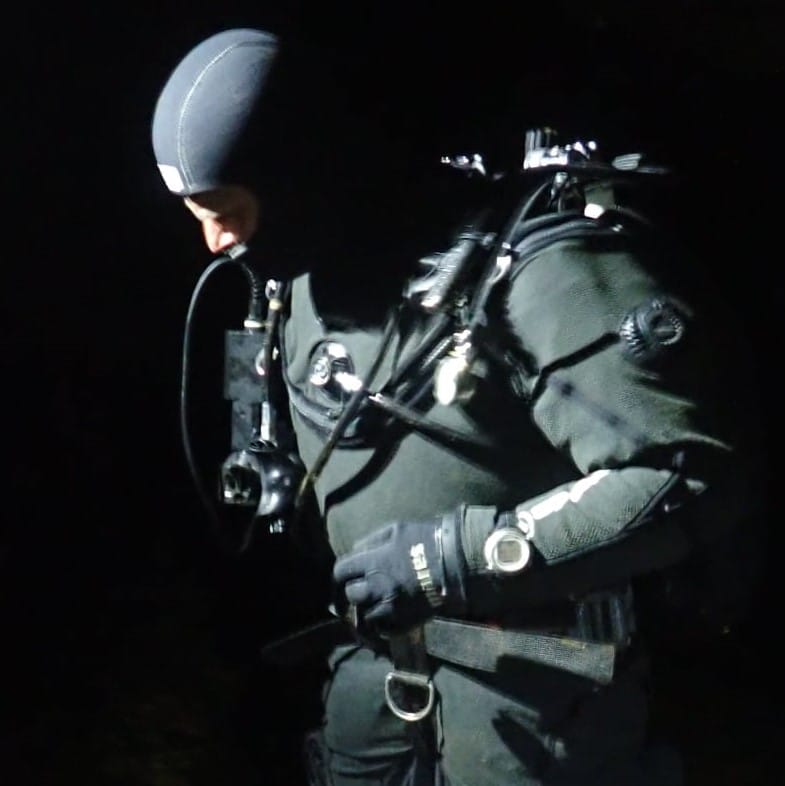Protecting the magical underwater world that lies beneath the Balkans
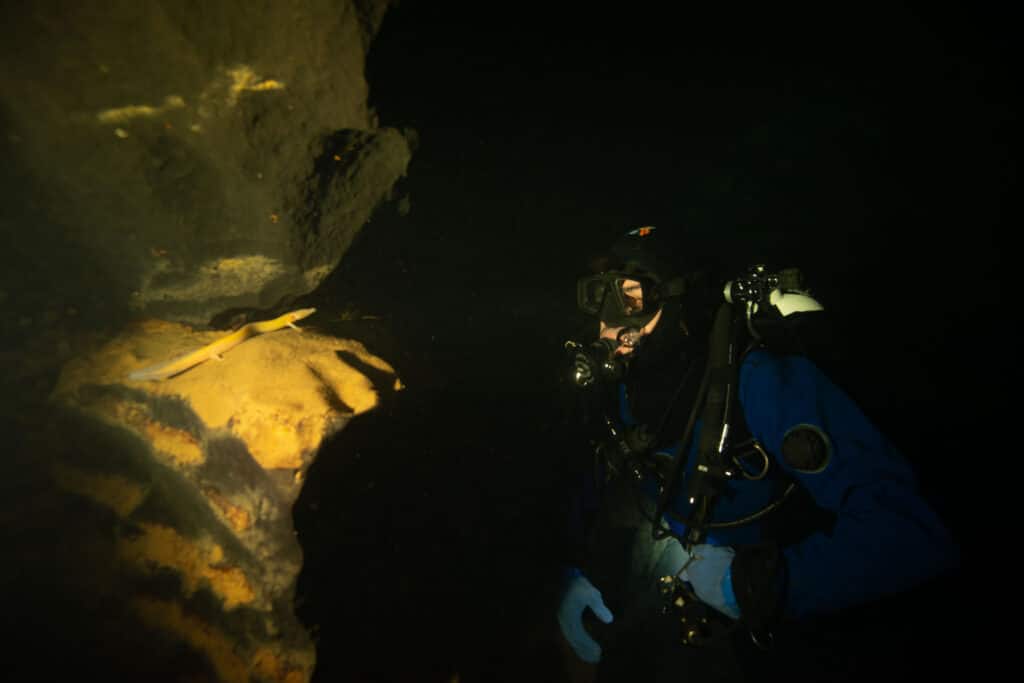
Could you conduct your research from the bottom of a subterranean lake? This is the reality for scientists who wish to find out all they can about the remarkable cave-dwelling wildlife of Bosnia & Herzegovina – before it’s too late
By Jessica Law
Header Image: The Olm is nicknamed the ‘human fish’ due to its fleshy skin colour. Another ‘human fish’, Dušan Jelić discovered 200 Olms on one cave dive © Vedran Jalžić
Read the article in Serbo-Croatian here – Članak na srpsko-hrvatskom jeziku pročitajte ovdje
Pale and slender with fine, fringed gills, you could be forgiven for thinking that the Olm Proteus anguinus came from another world entirely. And in a way, you’d be right. This rare freshwater salamander is eyeless, devoid of pigment and possesses only the smallest, most delicate of limbs. To us humans, it can seem like there is something missing. But in reality, it is perfectly adapted for life in subterranean caves beneath the Dinarides mountains in the Balkans, Europe. In fact, the Olm is found nowhere else on earth. With a heightened sense of smell and hearing, the ability to resist long-term starvation and even a newly discovered sensory organ that detects the electric fields of other animals, it has everything it needs to survive in this secluded environment.
Like its occupants, the limestone caves of the Dinarides are truly exceptional. In some places, vast stalactites and stalagmites create stunning, cathedral-like formations, while other areas preserve fossils from former millennia. This is the location where naturalists discovered cave-dwelling animals for the first time, creating a whole new branch of biology. The Olm and its fellow cave-dwellers may be perfectly suited to life underground here, but the humans that wish to study them are not. To discover more about the unique wildlife that inhabits these limestone caverns, modern researchers need to be cavers, divers and fishers all at once. But why go to all this trouble?
The reason is an urgent one: we need to discover all we can about this remarkable ecosystem before it is lost forever. The Balkans’ last remaining wild waterways are threatened by proposals for dams, hydropower projects and many other modifications. “Building dams is disastrous for the very sensitive organisms that inhabit places with such specific conditions,” says Marijana Demajo, BPSSS (BirdLife Serbia), Balkans Small Grants Co-ordinator for Critical Ecosystem Partnership Fund (CEPF) Mediterranean*. “Underground life depends on the water level; it’s fed from the surface watercourses.”
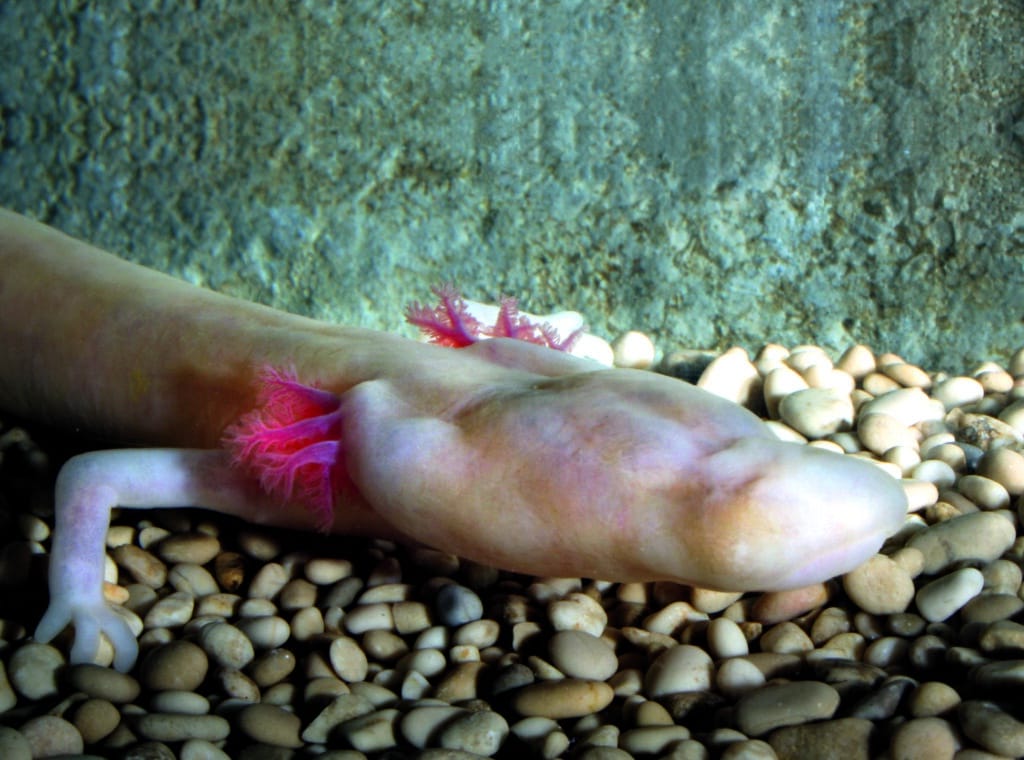
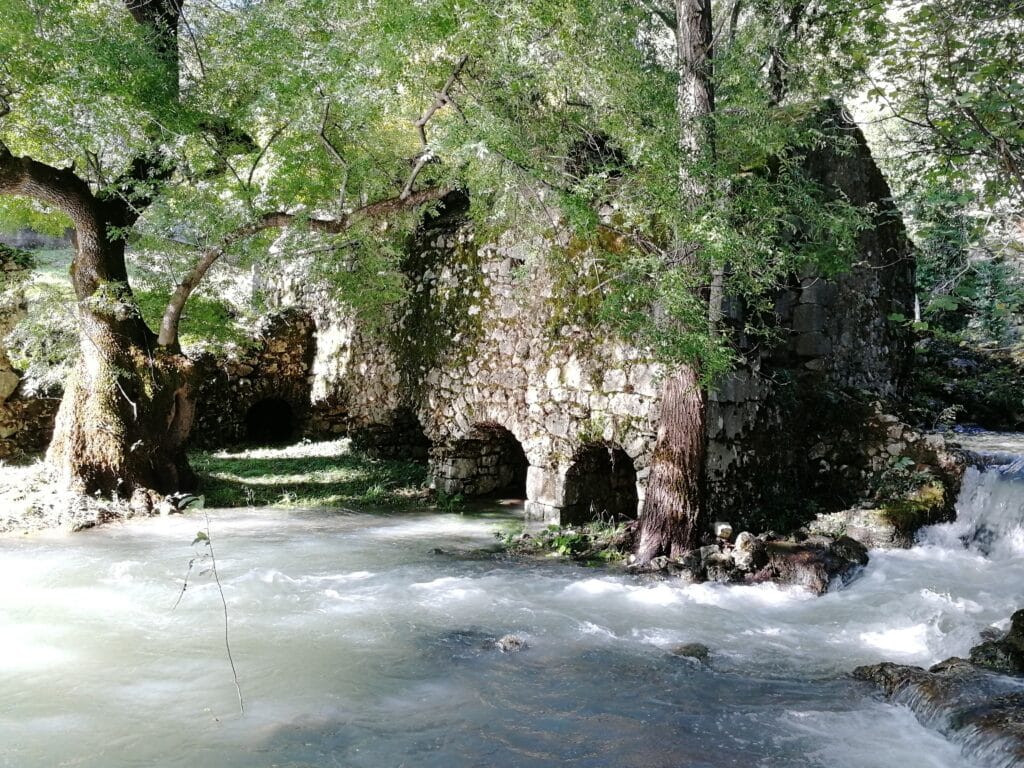
For example, when the Trebišnjica River was enclosed in artificial concrete channels in Bosnia & Herzegovina, it cut off the natural flood water that usually reached sink holes at the edges of the Popovo Polje plains. As a result, large colonies of exclusively cave-dwelling tube worms were completely killed off within the sink holes. Fortunately, the more we know about an ecosystem, the more information we have to make positive change to policy. And so CEPF brought together experts from the Subterranean Biology Lab at the University of Ljubljana, Slovenia, and the Center for Karst and Speleology, based in Bosnia & Herzegovina. Together they formed the SubBio Code project. Their mission: to develop new tools to identify and catalogue the rich underground biodiversity of the Dinarides region in Bosnia & Herzegovina.
“This a landscape full of life, not some lifeless place. The discovery of new species is important in order to demonstrate the true value of karst [limestone] landscapes, and to show that they are not just geomorphological formations, but a living system,” asserts Demajo. “And let us not forget the importance of educating the local community.”
This March, researchers braved freezing snow and flooded caverns (and multiple COVID tests) as they ventured back out into the field to survey this little-known network of caves. Over just a few days, they advanced the knowledge of the habitat and its wildlife further than ever before. One day, researchers were sampling springs for shrimp-like amphipod crustaceans when they met local people who, surprisingly, knew about the shrimps’ existence and had given them the name šmugarica. Later the same day, they dispelled a false rumour about the cave Ratkovića Pečina, which was thought to stretch far back into the hills but turned out to be of normal dimensions. Towards the end of their visit, a local caver showed them a cavern full of bats whose guano provides nutrients for a thriving ecosystem of invertebrates. The team used their abseiling and rock-climbing experience to survey the area vertically and visit three caves in the side of Korita hill.
Rock climbing is just one of the practical skills that team members have acquired as part of the project’s mission to train and educate scientists, students, volunteers and the local community in the research and conservation of these caves. As well as netting creatures directly from the water, the team also uses an exciting new technique using eDNA (a shortening of ‘environmental DNA’), developed by a previous CEPF-funded project as a way to detect the presence of Olms without capturing and disturbing them. eDNA is the genetic material that gets released by animals as they go about their lives – in the form of skin, mucous, faeces and many other kinds of fragments. Scientists are able to detect this material in the water and identify which species it belongs to, helping them to map its distribution and make conservation plans.
“It is an amazing experience to see something that only a few people in the world have seen before you – or occasionally, to be the first person ever to see it.”Dušan Jelić, Croatian biologist and cave diver
As fascinating as this is, no part of their research is as nail-biting as underground diving. Croatian biologist and cave-diver Dušan Jelić, who discovered the largest known population of Olms in his native country, explains what it’s like to put on full scuba gear and venture beneath the surface of the water to observe first-hand the creatures that inhabit the gloomy depths. “It is an amazing experience to see something that only a few people in the world have seen before you – or occasionally, to be the first person ever to see it. Sometimes it can be scary, just to be underwater, in a small space, isolated from the rest of the world … but mostly it is a wonderful feeling.”
It is a rare privilege to venture into the realm of the Olm, however fleetingly. And though these creatures are perfectly at home in the dark, by shining a light on them we can secure lasting safety for the unique and beautiful world that lies beneath our feet.
Ground-breaking research into rare cave-dwelling fish
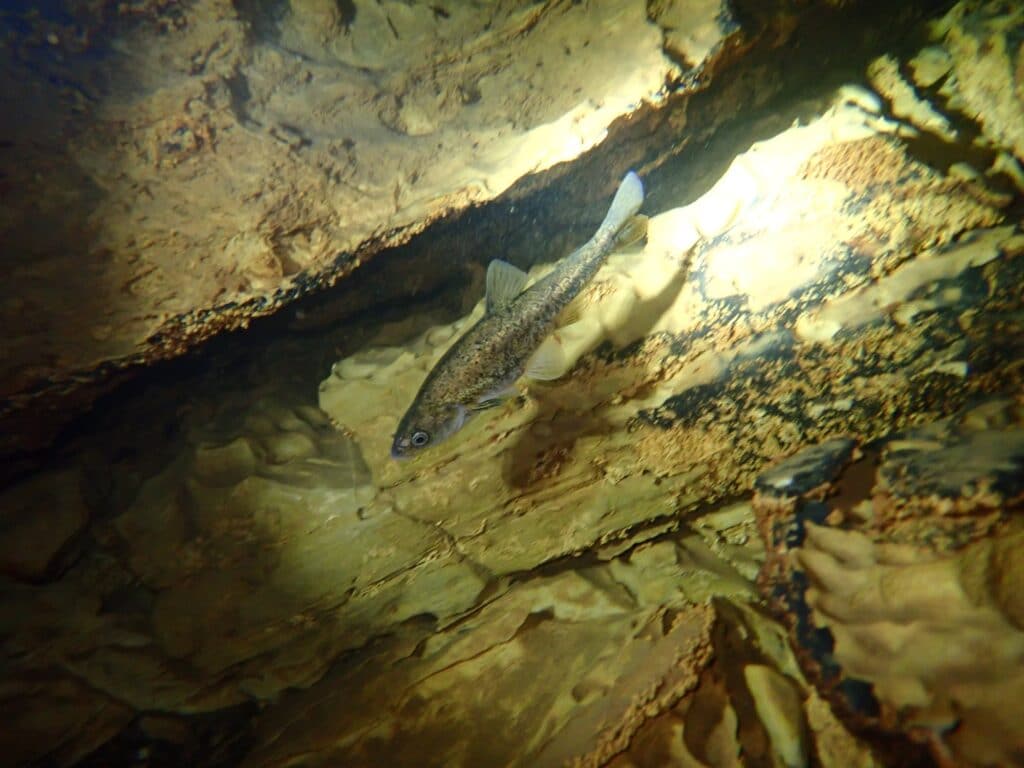
In 2020, another exciting new project by the Croatian Biological Research Society set out to investigate the Southern Dalmatian Minnow Delminichths ghetaldii – a rare freshwater fish found only in southern Bosnia & Herzegovina and Croatia. Although the species is already known to use caves, this project could confirm its status as Europe’s first exclusively cave-dwelling fish. During September and November, researchers surveyed 19 caves through fishing and cave diving, and consulted experts from Croatia and France to set up eDNA methods. They are also laying the foundations for a conservation plan for the species, and forming a network of experts and decision-makers through which to share knowledge.
“We’re working on a rare fish, so it’s really amazing when you actually find it – especially in large numbers, or in places where you don’t expect it to be present,” says project co-ordinator Matej Vucić. “It’s a really good feeling to know there is still hope to save something you’re working on – but only if everyone acts quickly and seriously.”
“It’s a really good feeling to know there is still hope to save something you’re working on – but only if everyone acts quickly and seriously.”Matej Vucić, project coordinator
New freshwater snail species discovered
The Center for Karst and Speleology discovered five species of snail never before seen in Bosnia & Herzegovina, as part of a project to survey the country’s freshwater snail populations and the water quality of its limestone rivers and springs. In an exciting turn of events, four of the snails were completely new to science. One of the snail species was discovered during a field trip as part of a student workshop, showing that training new researchers can sometimes pay off instantly!
More worryingly, the team also found species of invasive freshwater molluscs, including the limpet Ferrissia californica, which had come all the way from North America. The next step will be to define the conservation status of the native snails on the IUCN Red List of Threatened Species.
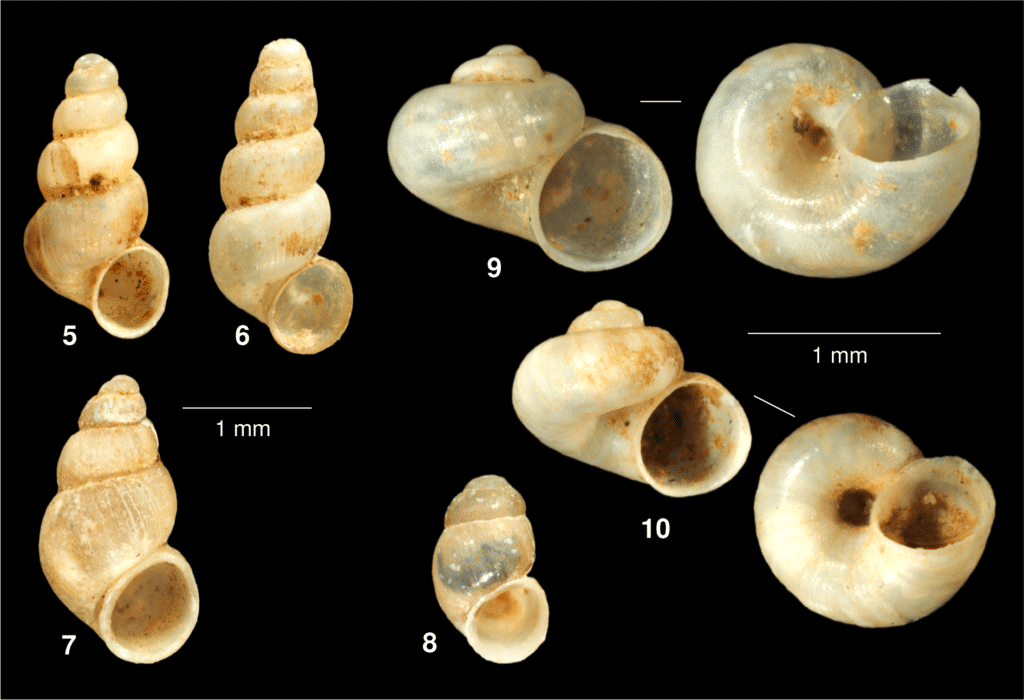
Improving knowledge of the Subterranean Biodiversity in Bosnia and Herzegovina is just one part of University of Ljubljana’s project that aims to develop new tools to identify and inventorize the rich subterranean biodiversity of the Dinarides region in Bosnia. As part of our Lessons Learned series to share advice from civil society organisations, here’s some conservation insight from Dr. Maja Zagmajster, SubBIOCODE Project coordinator at University of Ljubljana:
“where there is a will, there is a way. Believe in your idea and do not give up even if you think nothing is working”
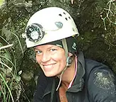
Your project is tackling an important conservation problem. What inspired you to find a solution?
The Dinarides in the Western Balkans is a globally significant and exceptional region regarding the richness of species that live exclusively in subterranean habitats. Within this global hotspot of subterranean biodiversity, there are two areas with the highest subterranean species richness. One in the southeast includes the Trebišnjica River catchment in southeastern Bosnia and Herzegovina. The region consists of a number of karst fields connected by surface and underground water flows. Although it is an area of global importance for subterranean biodiversity, this world’s natural heritage is under threat.
In the mid-1960s, construction of a series of hydroelectric power plants (HE) began on the Trebišnjica River, where a large part of Popovo polje has been severely affected by river channels, dams and tunnels built for HE. Recent socio-economic development in the region has revived plans for several hydropower plants and tunnels also in the Upper horizons of the river catchment. As a result, the natural water regimes and connectivity are altered, and this exceptional subterranean biodiversity is severely impacted.
As part of the project, we considered it extremely important to improve knowledge of the region’s subterranean species and facilitate access to all data for decision-makers to use in conservation and planning efforts. We evaluated conservation statuses as well as important sites for conservation. We have established a web interface for an online database that is a unique example of open access to such data. A critical aspect was also to educate the general public, students, cavers and natural scientists about the value of subterranean biodiversity. Protecting this natural heritage also means protecting groundwater, the vital source of drinking water.
Tell us one big lesson that you’ve learned from this project.
In general, where there is a will, there is a way. Unfortunately, our project was affected by the pandemic shortly after it started. This prevented us from travelling and conducting field research for a year. We decided to approach project implementation differently. Since we could not go into the field, we devoted our energy to analysing samples stored in our collections from previous field research expeditions in the project area.
We also found a way to reach interested individuals by organising online lectures and networking using online tools. While this was not ideal, it was the right way to move project activities forward. When we were finally able to travel and involve interested cavers and students in the fieldwork, it was a big step forward. It is important to involve the people who live in the areas because they are the ones who have a direct interest and benefit from a protected environment.
Given your experience working on this project, what advice would you have for another conservationist in the Mediterranean who is just starting out?
Believe in your idea and do not give up even when you may think it will not work. Do not be afraid to tackle even the most complicated conservation issues; even a tiny difference you can make to improve conservation is worth it. Involve local communities and all interested stakeholders to show them that change and a different perspective are possible.

*The Critical Ecosystem Partnership Fund (CEPF) is a joint initiative of l’Agence Française de Développement, Conservation International, the European Union, the Global Environment Facility, the Government of Japan, and the World Bank. Additional funding has been provided by the MAVA Foundation. A fundamental goal is to ensure civil society is engaged in biodiversity conservation.
CEPF is more than just a funding provider. A dedicated Regional Implementation Team (RIT) (expert officers on the ground) guide funding to the most important areas and to even the smallest of organisations; building civil society capacities, improving conservation outcomes, strengthening networks and sharing best practices. In the Mediterranean Basin Biodiversity Hotspot, the RIT is entrusted to BirdLife International and its Partners: LPO (BirdLife France), DOPPS (BirdLife Slovenia) and BPSSS (BirdLife Serbia).Find out more at www.birdlife.org/cepf-med



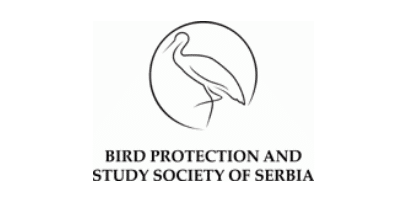
Stay up to date
Sign up to receive the latest bird conservation news. You’ll also receive updates about our projects, science and other ways to get involved including fundraising.
Thank you for your support, we are committed to protecting your personal information and privacy. For more information on how we use your data, please see our Privacy Policy. You can unsubscribe from emails at any time by using the link in the footer of any email from us.


